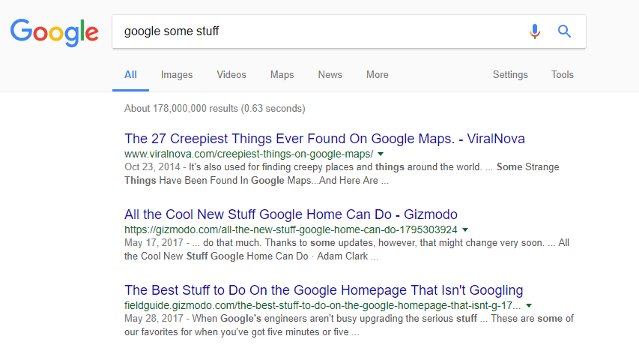
I welcome you back, dear readers of our WebCEO blog! In a previous entry, we shared with you a list of 7 Actionable Tips for Performing SEO in Fashion Industry. It’s time to pick up from where we left before and continue with even more advanced SEO tips for fashion websites. Without further ado, today’s update begins riiiiiight now.
1. Keep Your Fashion Blog Well-Optimized
Fashion is a spring that never runs out of new things to put on display. We can ignore for the moment that new is often long-forgotten old. Humans are drawn to news and novelties. We like new things and we like looking at them and reading about them, especially when they leave a strong impression. Your audience’s curiosity can be turned into extra traffic and and a more solid brand reputation, so it’s important to keep your blog SEO-friendly in terms of searches for new and novel keywords.
Optimizing a blog is easier than an ecommerce website. You have more freedom with what kind of content you can prepare, but the guidelines for successful SEO still apply. Remember to follow these steps on your blog:
- Use keywords where they matter most. Those places include the URL address, the title tag, the meta description tag, H1-H4 tags, image names and alt attributes and the text’s body. Be careful not to overstuff your pages with the same keywords as it can hurt your rankings. Using the WebCEO’s Keyword Research tool can help you identify the right keywords to use and avoid keyword stuffing.
- Optimize your images. As mentioned in the previous post, being careless with images can and will cause your website to load slowly, and nobody likes a slow-loading website. Minimize those kilobytes while preserving the quality by choosing the right file format, tweaking the dimensions and compressing the file.
- Write content that is original (no plagiarizing!), well-formatted and fulfills the user’s goal for visiting the page.
2. Put Schema Markup on Your Site
Most search results look like this:
We can observe the bare minimum: the page’s title, link to the page and a meta description (which is often just the page’s truncated text). Sometimes there’s the date on which the page was created, too. Sometimes there isn’t one. This indicates that you can make certain information be displayed in search results before the user even clicks on them. In other words, you can make search results for your website more useful.
The best way to accomplish that is to use schema markup on your site.
What is schema markup, you ask? There isn’t enough to it to make it scary. Using schema markup means adding a few lines of HTML code on some of your website’s pages – the ones you want to display extra information for in Google’s search results. Google (or any search engine, for that matter) will detect that code and convert it into a snippet with helpful info. For example, it could be your company’s review rating, your product’s price or just your telephone number. That is, of course, assuming you don’t make any mistakes in writing the HTML code: it’s entirely possible to put your rating where your phone number should be. So be careful.
This is what an informative search result looks like. Go ahead and make one for your own site!
3. Make Your Site Mobile-Friendly
Browsing the Internet on a mobile device is a different experience from doing it on a PC. Smaller screen, no keyboard or mouse – in those conditions, it’s honestly surprising how mobile users keep growing in number and even overtaking desktop users. And yet the shift was so monumental that it prompted Google to roll out the Mobilegeddon update in 2015 and now the mobile-first index. In other words, webmasters need to get with the times; rejecting mobile SEO will lead their sites to nothing but doom and failure.
You can take these steps to make your fashion site mobile-friendly:
1. Use responsive web design. It’s a one-size-fits-all solution and one of web design’s greatest achievements. Implementing a responsive design makes a website adapt to screens of any size (and those sizes do vary!), arranging a web page’s elements and tweaking their sizes to fit the display like a glove. Here’s a good tutorial for mastering responsive design – it’s easier than it sounds.
2. Include the viewport meta tag. A single line of HTML code in the <head> block will tell devices how to size and scale your website’s content: <meta name=”viewport” content=”width=device-width, initial-scale=1″>.
3. Be generous with font sizes. It’s best not to make users zoom in every time they want to read something. Make it readable from the get-go. Titles and headings above-the-fold should be the largest to guarantee the users will notice what the page is about. A font between 14 and 16 pixels everywhere else is fine.
4. Optimize Page Loading Speed: Mobile users are impatient and often close the tab if the site takes too long to load. You can achieve a fast loading speed by minimizing the page’s code, optimizing the images’ dimensions, and creating an AMP version of your site. Check with WebCEO’s Page Speed tool to see if you could give yourself a speed boost.
Be careful not to negate all that work by introducing elements that will ruin the browsing experience for users. See our mobile ranking factors guide for a full list of methods to make or break a mobile-friendly site.
4. Leverage NAP Citations
The digital era has made shopping easy and convenient. There are countless online stores where you can purchase anything without needing to show up at their doorstep. Despite that, businesses with live salesman-customer interactions aren’t getting fewer in number, nor are they expected to go extinct anytime soon. Is this related to SEO? Yes, I’m getting to that.
Online stores don’t (usually) need to worry about making their physical address known. Businesses with a brick-and-mortar location do, and this difference is important enough that it has earned a section in this post. This is so important that there is an acronym encompassing three essential components: name, address and phone number. By their powers combined, they are NAP, the trinity of local SEO.
And NAP is what you want tightly associated with your site, with the help of both linked and unlinked mentions of it. You remember how links improve off-page SEO, right? When search engine spiders crawl links, they look at a number of factors, including the link’s anchor text (if there is one). That anchor text becomes a keyword associated with the site on the other end of the link. So take this principle to heart and use it to make your NAP synonymous with your business. You’ll see the effects in search results.
It’s also the principle behind Google bombing, but that’s a story for another day.
5. Collect and Display Customer Reviews
Advertising campaigns can be powerful, but they cause skepticism in their viewers. That’s not the case with customer reviews, at least not to the same extent. We perceive customers expressing their opinions about products and services they’ve used as much more trustworthy than the most detailed commercial. It’s bad for bad businesses and good for the better ones. If karma exists, customer reviews are it!
Offering high-quality products and good service earns gratitude from your audience. This gratitude can be easily turned into positive reviews: most customers will leave one if you ask them to. Collect as many reviews as you can and put them in two places where they’ll be the most useful to you:
- A dedicated page, where your visitors can see words of praise from everyone you have helped.
- A review schema, so your reviews will appear in search results and instantly win your prospective customers’ trust.
Having a few negative reviews doesn’t hurt, as long as there aren’t too many. A small number makes your company look genuine: it’s impossible to please everybody, after all. Just don’t go provoking your customers to make them leave bad reviews.
6. Be Active in Social Media
Among the best places to promote everything related to fashion are social media platforms. On Facebook alone, pages about fashion gather millions of followers – but why stop there? Every major platform has witnessed at least one stunningly successful fashion campaign. Yours could be next!
Keep in mind that not all networks are equally good for your goals, though. Facebook is the best social media platform for raising brand awareness thanks to the sheer amount of ways to manage content on it. Others, like Pinterest and Instagram, prefer images to other types of content. This turned them into a dreamland for those who want to promote or simply discuss clothing brands; Pinterest in particular specializes in brands for women. On the other hand, you have platforms like Google+, which is more accepting of the technology industry. Research is the foundation of every good plan! Spend some time to look into things now in order to avoid disappointment in the future.
Choose the best platform for your needs, create a page on it and post there regularly. If your content is interesting and shareable, your audience will be glad to exchange words with you.
7. Write Guest Posts for Fashion Blogs
Guest blogging only keeps on evolving as an off-page SEO method, and fashion remains a valid niche to write about. There’s a plethora of fashion blogs that accept guest posts; here’s a whopping 100 of them to get you started. The only catch is that most of them are picky about topics and won’t accept just any post you send them. On the other hand, if your material fits their requirements, you’re golden.
Be sure to check the blog’s domain authority before you decide to publish yourself there. If it’s significantly lower than yours, you might not want a backlink from there.
8. Give Interviews and Interview Others
Now for one of the more advanced off-page SEO techniques. In order to pull this off, you need to possess a certain amount of authority and fame in your niche – at least slightly more than a rookie’s. It’s obvious why: what can an average Joe Shmoe say in an interview, and who’d want to read it? You need to make a name for yourself first and be well-versed in your trade so you could answer any questions. Let’s assume you have fulfilled both conditions and proceed.
How does one become an interviewee? The most renowned thought leaders receive emails with invitations, but the majority of us aren’t that lucky. Your best bet is to find a website that specializes in interviews on fashion, or better yet, find a person who has recently been interviewed and can show you the ropes. Volunteer for whichever type of interview suits you most: individual, group or podcast. If everything goes smoothly, you’ll score a backlink on the interview website and gain exposure for yours.
Being on the receiving end isn’t the only option. Just as well, you can interview someone related to fashion, post it on your site and then ask them to link to it from their own site. This task gets progressively harder the bigger an expert your interviewee is; fortunately, high difficulty equals high reward in this case.
9. Perform an SEO Competitor Analysis
You can find inspiration in sneaking a peek at your competitors. How did they manage to overtake you despite working in the same conditions? If you ask them directly, all they’ll give you is a joke answer – and that’s if they are in a good mood. No, you’ll get much better results by closely observing them. All you need is a good eye and a package of first-class SEO tools.
How do you do a competitor analysis in SEO and what useful information can you obtain from it?
1. Check your shared keywords. If your competitors are outranking you for some of the keywords you are using, shedding them for new ones is always an option. Use WebCEO’s Competitor Rankings by Keyword to see who ranks the best for your set of keywords. The results on the table will show if there is a point in fighting on or if it’s an uphill battle with no hope of winning.
2. Analyze their backlinks. Your potential backlink providers may be hiding among your rivals’ supporters. But they can’t keep hiding from you if you find them with WebCEO’s Competitor Backlink Spy. Bring up the list of sites linking to your competitors and see who could be a good fit for you. Of course, it will be entirely up to you to secure backlinks from them. A more advanced trick is finding backlink providers who are NOT on the list. This is where you will get the chance to outmaneuver your rivals.
3. Monitor their social activity. Who doesn’t have a page in social media these days? Your competitors are most likely leveraging several platforms to interact with their audience (your audience). What means are they using to receive feedback? What do they post (images, polls, infographics et al) and how often? What is the most effective way they provoke user engagement? You’ll have to thoroughly analyze your competitors’ social pages to answer those questions. But first, start with WebCEO’s Competitor Social Citations tool to see who’s getting the most engagement.






